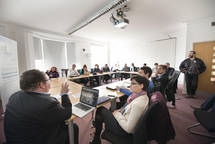Citizen Cultural Participation
Different European projects responsibles and students joined the CreativeCH workshop in Brighton on 21 November 2012, in order to explore and identify active and participatory ways to engage citizen in the promotion and valorization of Cultural Heritage.
Project managers, scholars and students joined the CreativeCH workshop at the VAST conference in Brighton to present and discuss how citizens can be involved in the documentation and communication of cultural heritage.
The workshop focused on participatory approaches and aspects such as what citizens perceive as heritage, how they related to it, and what benefits they can gain from collaborative projects.
Internet and other digital technologies allow for new ways for citizens to access, explore and add to cultural heritage content. The benefits of information portals and other digital outlets of heritage organizations for citizens are not always clear; indeed, often they present an institutional, authoritative expert view of cultural heritage objects and sites.
Therefore a core theme of the workshop discussion was how to deploy novel technologies in ways that engage citizens, allow them to share their views and gain added value from collaborating with heritage professionals and other community members.
Six examples were presented, each covering a different segment of cultural heritage, different communities, and different ways of involvement.
The first presentation by Ricardo Trindade introduced the Heritage of Portuguese Influence Portal. The portal is sponsored by the Fundação Calouste Gulbenkian (Lisbon) and involves several Portuguese universities in documenting and presenting the built heritage of Portuguese origin around the globe. Non-experts such as local residents or travelers are invited to contribute content (images, videos, descriptions, stories, etc) which, after editorial examination, is published on the portal. This example triggered a discussion about what contributions of citizens are seen as appropriate, with the conclusion that fit or non-fit depends on the particular objectives and context of a project.
The second example were the Sassi of Matera (Italy), a Unesco World Heritage site representing the most complete surviving rock-cut settlement in the Mediterranean region. Andrea Adami of the Italian National Research Council’s Institute for Technologies Applied to Cultural Heritage presented how the history of this site will be brought alive online. The communication platform is developed as part of Matera’s candidacy as a European Capital of Culture of 2019. The residents actively contribute views and visions of their home town to the project. The platform is not intended to replace the local guides who are residents telling their stories of what it means to grow up and live in this unique town.
The third presentation was given by Angela Rossmaier (EuroMachs project, Austria), the winner of the first CHIEF Award. She focused on how city archives can stimulate citizens to explore the history of their city and use historic content as inspiration for creative activities. Examples of such content included pictures of historic costumes and hats, music scores and cooking recipes.
Another case study investigated how capture-from-motion technology (a method of creating 3D models from digital photographs) can be used at a large scale for documenting statues within the public urban space. Karina Rodriguez Echevarria (Brighton University, UK), a researcher in the European project 3D-COFORM, described how citizens were invited and trained to provide photos of statues in their home town. The case study found that many citizens are willing to devote time for such work, if they can focus on cultural objects they like and the technical part is as easy as taking pictures with a digital camera.
The fifth example was presented by Kyprianos Kountouris, the director of the Pyrga Primary School that is located in a village in Cyprus. Though small the village is rich in cultural heritage, both buildings (chapels, mosque, fountains, etc) as well as traditional objects and customs. The project of the school aimed at understanding what children perceive as heritage, which also included older household objects and working tools. Moreover the children learned how to inquire local history and present their findings with digital tools.
Finally Raluca Selejan (West University of Timisoara, Romania) presented a case study for one of the CreativeCH showcases that is developed in the Banat region. The showcase focuses on the documentation and communication of traditions of rural communities in this multi-ethnic region. The study work with the local people inquires how these traditions are maintained, transformed or re-integrated within the communities.
The workshop presentations and discussion made clear that very different approaches can be chosen for involving citizens of all age groups in the creative use and valorization of tangible as well as intangible cultural heritage.
As the topic is complex there is no “one size fits all” solution. Yet, whatever methods and tools are used, the interests, motivations and aspirations of the participating citizens must be considered in the first place. Only truly participatory projects will allow citizens enriching experiences and “telling their stories” in collaborative heritage documentation and communication projects.
Next Workshops
Cultural Tourism
Terrassa, Spain, 10th May 2013, hosted at Fira Modernista (Noveau Fair)
Internationalisation and Localization of Digital Cultural Heritage
Florence, Italy, 16th May 2013, hosted at EVA Florence
FULL WORKSHOP REPORT
Download presentations
Andrea Adami - Matera, Tales of a City [2.54 mb]
Angelika Rossmaier - History Reloaded [CHIEF Award Winner] [7.48 mb]
Karina Rodriguez Echevarria - Documenting Heritage in 3D [1.84 mb]
Raluca Selejan - The Banat Showcase [4.96 mb]
Ricardo Trindade - HPIP [3.21 mb]
Videos
Videos of this and other workshops you can find here
Last Workshops
Creative Heritage and ICT in the experience economy | May 2012
Creative Clusters | April 2012




